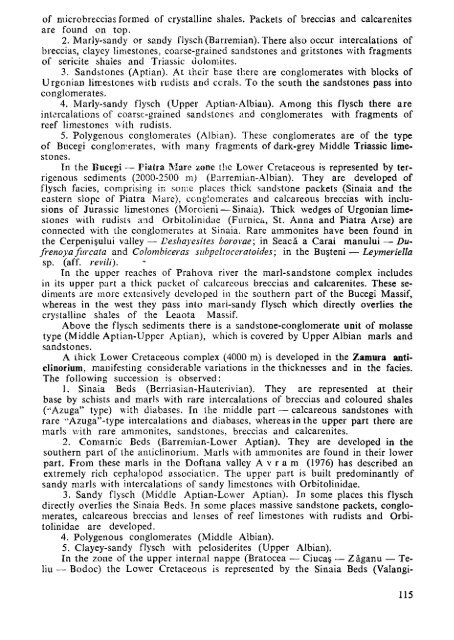THE MEDITERRANEAN LOWER CRETACEOUS
THE MEDITERRANEAN LOWER CRETACEOUS
THE MEDITERRANEAN LOWER CRETACEOUS
You also want an ePaper? Increase the reach of your titles
YUMPU automatically turns print PDFs into web optimized ePapers that Google loves.
of microbreccias formed of crystalline shales. Packets of breccias and calcarenites<br />
are found on top.<br />
2. Marly-sandy or sandy flysch (Barremian). There also occur intercalations of<br />
breccias, clayey limestones, coarse-grained sandstones and gritstones with fragments<br />
of sericite shales and Triassic dolomites.<br />
3. Sandstones (Aptian). At iheir base there are conglomerates with blocks of<br />
Urgonian limestones with rudists and corals. To the south the sandstones pass into<br />
conglomerates.<br />
4. Marly-sandy flysch (Upper Aptian-Albian). Among this flysch there are<br />
intercalations of coarse-grained sandstones and conglomerates with fragments of<br />
reef limestones with rudists.<br />
5. Polygenous conglomerates (Albian). These conglomerates are of the type<br />
of Bucegi conglomerates, with many fragments of dark-grey Middle Triassic limestones.<br />
In the Bucegi — Piatra Mare zone the Lower Cretaceous is represented by terrigenous<br />
sediments (2000-2500 m) (Barremian-Albian). They are developed of<br />
flysch facies, comprising in some places thick sandstone packets (Sinaia and the<br />
eastern slope of Piatra Mare), conglomerates and calcareous breccias with inclusions<br />
of Jurassic limestones (Moroieni — Sinaia). Thick wedges of Urgonian limestones<br />
with rudists and Orbitolinidae (Furnica, St. Anna and Piatra Arse) are<br />
connected with the conglomerates at Sinaia. Rare ammonites have been found in<br />
the Cerpenisului valley — Deshayesites borovae; in Seacâ a Carai manului — Dufrenoya<br />
furcata and Colombiceras subpeltoceratoides; in the Busteni — Leymeriella<br />
sp. (aff. rev/7/').<br />
In the upper reaches of Prahova river the marl-sandstone complex includes<br />
in its upper part a thick packet of calcareous breccias and calcarenites. These sediments<br />
are more extensively developed in the southern part of the Bucegi Massif,<br />
whereas in the west they pass into marl-sandy flysch which directly overlies the<br />
crystalline shales of the Leaota Massif.<br />
Above the flysch sediments there is a sandstone-conglomerate unit of molasse<br />
type (Middle Aptian-Upper Aptian), which is covered by Upper Albian marls and<br />
sandstones.<br />
A thick Lower Cretaceous complex (4000 m) is developed in the Zamura anticlinorium,<br />
manifesting considerable variations in the thicknesses and in the facies.<br />
The following succession is observed:<br />
1. Sinaia Beds (Berriasian-Hauterivian). They are represented at their<br />
base by schists and marls with rare intercalations of breccias and coloured shales<br />
(•'Azuga" type) with diabases. In the middle part — calcareous sandstones with<br />
rare "Azuga"-type intercalations and diabases, whereas in the upper part there are<br />
marls with rare ammonites, sandstones, breccias and calcarenites.<br />
2. Comsrnic Beds (Barremian-Lower Aptian). They are developed in the<br />
southern part of the anticlinorium. Marls with ammonites are found in their lower<br />
part. From these marls in the Doftana valley A v г a m (1976) has described an<br />
extremely rich cephalopod association. The upper part is built predominantly of<br />
sandy marls with intercalations of sandy limestones with Orbitolinidae.<br />
3. Sandy flysch (Middle Aptian-Lower Aptian). In some places this flysch<br />
directly overlies the Sinaia Beds. In some places massive sandstone packets, conglomerates,<br />
calcareous breccias and lenses of reef limestones with rudists and Orbitolinidae<br />
are developed.<br />
4. Polygenous conglomerates (Middle Albian).<br />
5. Clayey-sandy flysch with pelosiderites (Upper Albian).<br />
In the zone of the upper internal nappe (Bratocea •— Ciucas — Zàganu — Teliu<br />
— Bodoc) the Lower Cretaceous is represented by the Sinaia Beds (Valangi-<br />
115

















